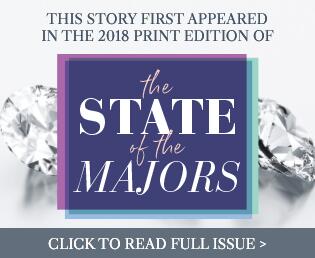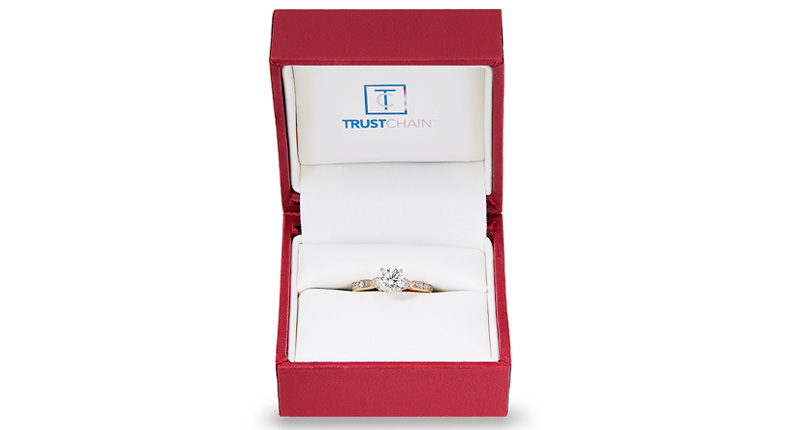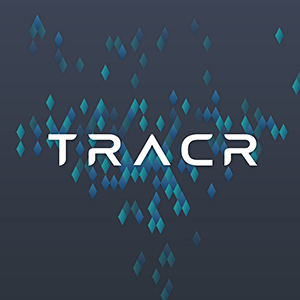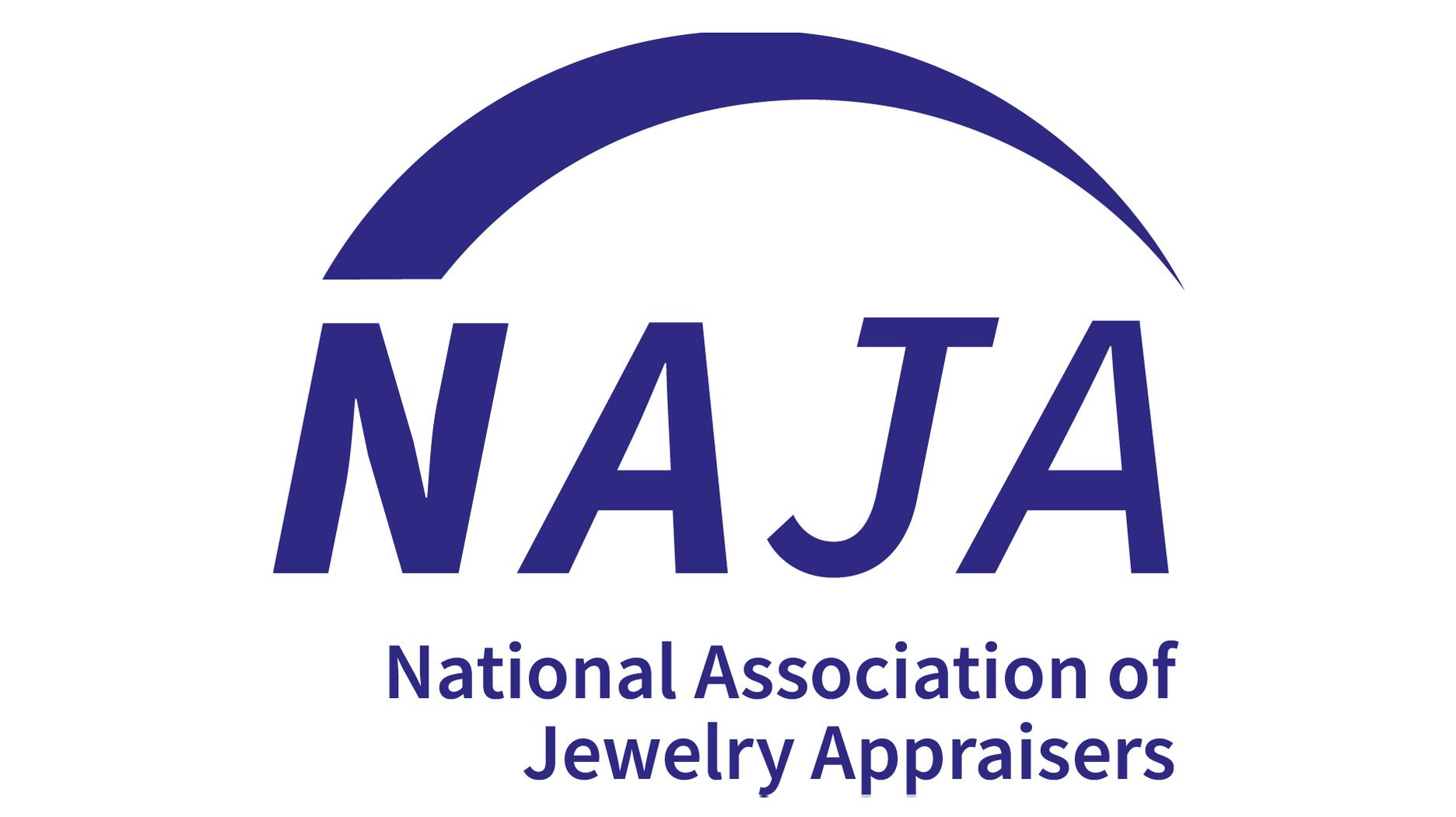Set in a Tiffany & Co. necklace, it sold for $4.2 million, the highest price and price per carat paid for a Paraíba tourmaline at auction.
State of the Diamond Industry: New Kids on the Block(chain)
Walmart uses blockchain to track food while Maersk keeps tabs on shipping containers. Here’s what industry leaders want it to do for diamonds.

While blockchain has many applications, its primary use in the diamond and jewelry business is to create a chain of custody, one that can, theoretically, guarantee consumers the diamond in their hands is mined, untreated and conflict free.

Blockchain initially was created as the electronic system for backing Bitcoin, the first cryptocurrency, which was founded by a person, or people, using the name Satoshi Nakamoto in 2009.
Today, a broad range of industries from retail to shipping are using blockchain to keep tabs on products, boost consumer confidence, increase efficiency and introduce unparalleled levels of transparency.
The diamond industry is hoping to do the same.
At its most basic level, blockchain is simply a new type of database.
Unlike “traditional” databases, blockchain is decentralized so instead of being controlled by a single person or entity, data is stored on thousands of computers, known as nodes.
Each node has access to the same data, which is updated across all nodes whenever a new transaction or series of transactions (a block) is recorded. For all practical purposes, every entry on the ledger is immutable, which means that once a transaction has been recorded, it cannot be changed or undone.
Gideon Greenspan, CEO of blockchain technology platform MultiChain, explains that there are two key differences between the “old” and “new” types of databases.
The first is that there has been a reduction in the number of people or companies (intermediaries) that stand between producers of goods and consumers of goods, a process called disintermediation. The second difference is greater transparency.
These two factors enable multiple parties who maybe don’t know—or fully trust—each other, to share a single database without needing anyone to oversee it.
Diamonds and the Blockchain
The diamond and jewelry industry has embraced the blockchain concept wholeheartedly, with a host of initiatives springing up at all points along the supply chain.
The Gemological Institute of America and Chow Tai Fook are using blockchain to bring diamond grading reports to consumers; diamond miner Lucara acquired Clara Diamond Solutions, which matches rough diamond production with polished manufacturing demand and uses blockchain technology to track diamonds as they move through the supply chain.

TrustChain, developed by a consortium of metal suppliers, refiners, manufacturers and a retailer, is using IBM blockchain tools to track both metals and diamonds as they move from mine to market.
Two of the most visible initiatives to emerge so far are Everledger and De Beers’ Tracr platform, which are both being built to track diamonds through the supply chain.
Everledger, a London-based start-up working to reduce risk and fraud for bankers, insurers and open marketplaces, has been tracking diamonds since 2015 and has added more than 2 million diamonds sized 0.3 carats and above to its system.
Since 2017, the company has been using the “Diamond Time-Lapse” (DPL) initiative, a tool originally developed by Mumbai-headquartered Dharmanandan Diamonds, to keep tabs on diamonds.
The DPL, which is open to the entire industry, tracks real-time data about a diamond’s journey from mine to retail and records information about each diamond’s origin, cutting and polishing, certification and transactions.
“[Tracr] will only maximize its potential if it is a platform developed by the industry on the behalf of the industry. [It will provide] a single source of truth for the diamond industry.” — Feriel Zerouki, De Beers Group
Diamonds ranging in size from 5-10.8 carats are given a Global ID, which records key attributes such as carat, color and clarity, and all transactions involving the diamond.
The Tracr system is being trialed in collaboration with some of the industry’s largest manufacturers—Venus Jewel, Diacore, Diarough, KGK Group and Rosy Blue NV—as well as one very big retailer, Signet Jewelers.
While no exact date has yet been given for a wider launch—the company is still bringing in key industry players and trialing the platform—De Beers expects to start integrating industry participants outside the pilot by the end of the year.
What is clear is that De Beers is designing Tracr for the industry to run independently, rather than De Beers overseeing it.
“[Tracr] will only maximize its potential if it is a platform developed by the industry on the behalf of the industry,” explains Feriel Zerouki, senior vice president of International Relations and Ethical Initiatives at De Beers Group.
It will, she says, provide, “a single source of truth for the diamond industry.”
One Chain to Rule Them All?
With so many different initiatives in the works, it appears there could end up being a number of sources of truth. One question being asked is, will these systems be able to communicate with each other?
Julie Yoakum, chief merchandising officer at Helzberg Diamonds, the retailer in TrustChain, believes integration is important, and notes that creating an inclusive supply chain that encompasses different blockchain platforms is a goal for many industries, not just jewelry.
Leanne Kemp, CEO and founder of Everledger, agrees.
“With all of these new and independent [blockchain] services having similar functionality with increased overlap, it has become clear we as an industry must now allow these networks to communicate with one another, the implementation of which… will revolutionize the way in which we interact with these infrastructures.”

Drawing on the London transport system as an example, Kemp explains while there are a number of independent means of transport both underground and above it, they can all be accessed using a single payment system (called the Oyster card) that allows users to easily and simply switch between different providers.
Who or what will be the industry’s “Oyster card” is currently unknown. One thing is clear, at least at this point—it will not include Tracr, which is not currently designed to interact with other blockchain ledgers.
That might not be as problematic as it sounds, however.
Greenspan, the blockchain expert, does not see the technical viability of full interoperability between different platforms.
He explains that it is still early days for blockchain technology, and multiple networks and experiments are to be expected. As time goes on, however, and systems become more fully developed, he would expect one particular blockchain to be adopted for each application.
Stumbling Block?
Interoperability is not the only logistical question to consider.
Another important one is how, or even whether, to add the billions of dollars’ worth of diamonds already in the pipeline, and in the hands of consumers, to the blockchain.
Initially, says Zerouki, Tracr will only register primary-sourced diamonds. Down the line, De Beers intends to create an entry point to add existing goods but believes the means of doing so must be discussed with the wider industry.
Kemp says she expects eligible materials, such as metals and diamonds, produced before a still-to-be set date will be grandfathered into the blockchain. This might include refining dates on precious metals bars, laser inscriptions on diamonds or even inventory records showing continuous ownership since before the cut-off date.
“For diamonds, it is proposed to allow one year for supply chain entities to clear existing inventory and use the volume to establish chain custody systems. Eligible diamonds are those that were owned before the set day, which must be demonstrated by inventory records of the entity that wishes to initiate a chain-of-custody with them,” she says.
It wouldn’t be the first time a large-scale grandfathering-in has occurred in the industry.
When the Kimberley Process Certification Scheme was established in 2000 to stop conflict diamonds from entering the legitimate diamond trade, all rough stock existing by Jan. 1, 2003 was “forgiven.”
Only goods mined after that date were subject to the certification process.
The Blockchain Benefits
There’s also the question of, what exactly adding blockchain to the industry will achieve and if it’s even the right tool for the job.
Greenspan asks a simple question about any proposed blockchain use case—what does a decentralized ledger provide that a regular or centralized database cannot?
Blockchain might make a tracking system such as Tracr, Everledger or TrustChain more palatable by removing centralized control, but the same result can be achieved—albeit with the insertion of a trusted intermediary—using existing tools. As Greenspan points out, diamond and jewelry components can be, and already are, tracked using regular databases.
In many proposed use cases, Greenspan says, a blockchain is not providing any value. Rather, he argues, the term “blockchain” is often used as a way of achieving funding and publicity.
He believes critical thinking needs to be applied to assess whether or not a blockchain is right for a particular job, and posits that, all too often, this is lacking in what he terms “the current over-hyped environment.”
Despite these reservations, blockchain seems to have caught on in a big way.
“Forensic approaches to identifying diamonds through emerging technology means they can be confidently tracked on the blockchain and, therefore, protect their future value.” — Leanne Kemp, CEO and founder of Everledger
Its decentralization and permanence are appealing to consumers who want reassurance about the provenance of their product. Although, as Greenspan points out, while blockchain removes the need for a trusted person to oversee the ledger, you still have to be able to trust the parties adding data to the ledger, especially at the start of the tracking process.
A lab-grown diamond falsely recorded as natural, or a mined diamond with an unreported treatment or fake Kimberley Process certificate, will still be just that as it moves through the supply pipeline, whether it’s being tracked using blockchain or not.
Once this trust is established, providing an identifiable, authenticated provenance will build the trust and confidence in the upstream stakeholders and, says Kemp, “consumers will have the peace of mind of knowing where their diamond comes from.”
She argues that when a valuable item lacks an identity, it loses its authenticity, ownership, existence and, ultimately, its value, which is something blockchain can prevent.
“Forensic approaches to identifying diamonds through emerging technology means they can be confidently tracked on the blockchain and, therefore, protect their future value.”
But that doesn’t necessarily mean they will have to with blockchain.
Both Zerouki and Helzberg’s Yoakum say diamonds tracked on the blockchain will not cost more than other diamonds.
Zerouki says the system is about meeting evolving consumer expectations and helping to address existing challenges in the industry, while Yoakum thinks there are already enough tracking and chain-of-custody systems to make blockchain price inflation unlikely.
She also says the technology can bring efficiencies to the market, providing real benefits to the industry and saving money along the way in the long run.
For example, verifying a diamond as conflict-free and mined at source (neither Tracr nor Everledger are registering lab-grown diamonds) and then tracking it as it moves through the supply chain removes the need for constant testing and verification and keeping track of reports since all the information is stored in an online digital certificate.
So instead of having to send a diamond to a lab for testing to verify it is untreated each time it changes hands, the new buyer can just check the details on the ledger, saving both time and money.
While blockchain is still an emerging technology, its growing implementation signals the start of a major digital shift that could change how the diamond business is conducted forever.
The Latest

The jeweler’s “Deep Freeze” display showcases its iconic jewelry designs frozen in a vintage icebox.

Take luxury gifting to new heights this holiday season with the jeweler’s showstopping 12-carat sphene ring.

How Jewelers of America’s 20 Under 40 are leading to ensure a brighter future for the jewelry industry.

This year's theme is “Unveiling the Depths of the Ocean.”


In its annual report, Pinterest noted an increase in searches for brooches, heirloom jewelry, and ‘80s luxury.

Starting Jan. 1, customers can request the service for opal, peridot, and demantoid garnet.

Roseco’s 704-page catalog showcases new lab-grown diamonds, findings, tools & more—available in print or interactive digital editions.

The 111-year-old retailer celebrated the opening of its new location in Salem, New Hampshire, which is its third store in the state.

The new catalog features its most popular chains as well as new styles.

The filmmaker’s personal F.P. Journe “FFC” prototype was the star of Phillips’ recent record-setting watch auction in New York.

The new location in the Design District pays homage to Miami’s Art Deco heritage and its connection to the ocean.

Inflations, tariffs, and politics—including the government shutdown—were among consumers’ top concerns last month.

Silas Smith of Meridian Metalworks won the challenge with his pendant that blends Australian and American landscapes.

The sale of the 31.68-carat, sunset-hued stone was part of Sotheby’s first series of events and auctions in Abu Dhabi.

Most customers who walk into your store this month have made up their minds. Your job is to validate their choice, Emmanuel Raheb writes.

The collection features characters and motifs from Ukrainian folklore, including an enchanted mirror and a magic egg.

MatrixGold 3.11, the newest version of the jewelry design program, offers more flexibility, precision, and creative control.

The pavilion will be part of the 2026 JA New York Spring show, scheduled for March 15 to 17.

Kadet, a 1994 National Jeweler Retailer Hall of Fame inductee, helped grow the family-owned retailer in the Chicago area and beyond.

Billed as the world’s smallest wearable, Lumia Health’s new smart earrings have a health tracker subtly embedded in the back.

Don’t let those with December birthdays feel blue. Help them celebrate their month with blue zircon, turquoise, and tanzanite.

The new pink sapphire version of the piece dances with its wearer in the brand’s “Icons After Dark” holiday campaign.

A choice that’s generated a lot of commentary, Pantone says “Cloud Dancer” marks a fresh start and encourages relaxation and creativity.

The manufacturer’s holiday campaign features a gift guide filled with trending designs and jewelry that can be personalized.

The man was charged with theft, accused of ingesting the necklace while in a jewelry store in Auckland, New Zealand.

The Florida independent expanded its store from 8,000 to 14,000 square feet, fulfilling the vision of its late co-founder, Jim Dunn.


























